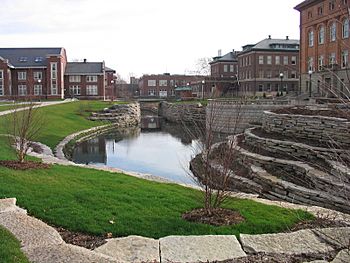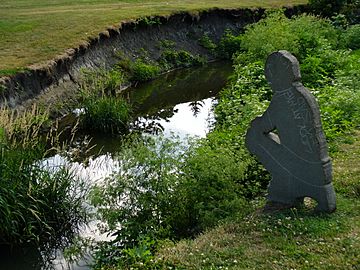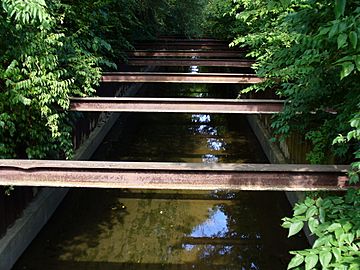Boneyard Creek facts for kids
Quick facts for kids Boneyard Creek |
|
|---|---|

The Boneyard flows through the UIUC Engineering Campus
|
|
| Physical characteristics | |
| Main source | City of Champaign, Illinois 40°07′30″N 88°14′16″W / 40.1250317°N 88.2378271°W |
| River mouth | Confluence with the Saline Branch, Urbana, Illinois 728 ft (222 m) 40°07′N 88°12′W / 40.12°N 88.2°W |
| Length | 3.3 mi (5.3 km) |
| Basin features | |
| Progression | Boneyard Creek → Saline Branch → Salt Fork → Vermilion → Wabash → Ohio → Mississippi → Gulf of Mexico |
| GNIS ID | 422378 |
The Boneyard Creek is a 3.3-mile-long (5.3 km) waterway. It flows through the cities of Champaign and Urbana, Illinois. This creek is a small part of a much larger river system. Its water eventually reaches the Saline Branch, then the Salt Fork Vermilion River, the Vermilion River, the Wabash River, the Ohio River, and finally the mighty Mississippi River before flowing into the Gulf of Mexico. The Boneyard Creek also runs through the northern part of the University of Illinois at Urbana-Champaign campus.
Contents
What is the Boneyard Creek?
The Boneyard Creek is a very important waterway for Champaign and Urbana. It helps drain rain and other water from a large part of these cities. This means it collects water from streets and land, carrying it away.
How the Creek Has Changed
A long time ago, before people settled here, the Boneyard Creek was likely a series of wet, marshy areas. It probably didn't have a clear path like it does today. As towns grew, people changed the creek. They made its path straighter and deeper. Now, much of the Boneyard flows in a narrow ditch. Steel walls line many parts of its banks. This helps control the water flow.
Fun Facts About the Name
Have you ever wondered how the Boneyard Creek got its name? There are a few interesting stories!
One story says that Native American people used to hang their dead over the stream. The bones would then fall into the creek. This story suggests the creek was full of human bones when the first settlers arrived. However, no human bones have ever been found during digging projects along the creek. So, this story might just be a legend.
Another story, popular at the University of Illinois, is a bit of a joke. It says the name "Boneyard" comes from the bones of students who struggled with the university's tough engineering classes!
Keeping the Creek Clean
Years ago, the Boneyard Creek was very polluted. It had a bad smell, and trash floated in it. This was before people understood how important it was to protect our environment.
Cleaning Up the Water
In the 1970s, people started working to clean up the creek. Many sources of pollution were removed. Slowly, the water quality got better. For example, a nearby sewage treatment plant used to add chlorine to the water it released. This chlorine killed most of the living things in the creek. In the late 1980s, they stopped using chlorine. After that, fish began to return to the Boneyard Creek!
However, even today, the fish in the Boneyard can face challenges. Sometimes, spills or accidents in the city can cause many fish to die. This shows why it's so important to protect our waterways.
Dealing with Flooding
The Boneyard Creek helps manage water, but it can also cause flooding. This is especially true after heavy rains.
Solving Flood Problems
In the 1920s, a problem called "Lake Neil" appeared. This happened when railroad tracks were raised in one area. The tracks blocked a branch of the Boneyard Creek. After it rained, water would build up, creating a temporary lake. This flooding would slowly go away as water flowed through pipes under the tracks.
Later, in the 1980s, bigger pipes were put under the tracks to stop "Lake Neil." But this caused flooding in other areas, like near Fourth and Green streets. This new flooding damaged homes and businesses.
To fix this, the City of Champaign built a huge basin in the late 1990s. This basin is like a giant bowl designed to hold extra water when the Boneyard Creek gets too full. It cost about $22 million to build. This basin helps prevent flooding in the Fourth and Green streets area, even during very big storms.
Exploring the Boneyard Greenway
The Boneyard Greenway is a special path that runs alongside the Boneyard Creek. It's a great place for walking and biking. The path goes from S 1st Street to S 6th Street. Students, teachers, and local people use this path. It helps them get around campus without having to use busy sidewalks and streets.





